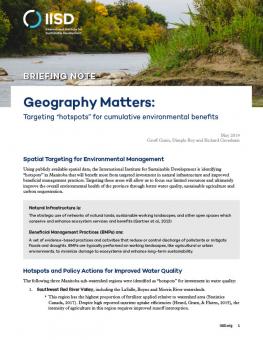
Geography Matters: Targeting "hotspots" for cumulative environmental benefits
Using open data from a variety of sources, we demonstrated how Manitoba can target its limited resources to deliver public programming to agricultural regions and gain better outcomes.
Key Messages
Using publicly available spatial data, we identified “hotspots” in Manitoba that will benefit most from targeted investment in natural infrastructure and improved beneficial management practices.
The three "hotspots" we identified for improved water quality are Southwest Red River Valley, Southwestern Manitoba and Southeast Red River Valley.
Targeting these areas will allow us to focus our limited resources and ultimately improve the overall environmental health of the province through better water quality, sustainable agriculture and carbon sequestration.
Geographic targeting, using new and historical datasets, is an important tool for environmental programming in Manitoba. Provincial priorities—including improved water quality, sustainable agriculture and carbon sequestration—can all be assisted by a geographically targeted approach to management actions.
Using publicly available spatial data, we identified “hotspots” in Manitoba—Southwest Red River Valley, Southwestern Manitoba and Southeast Red River Valley—that will benefit most from targeted investment in natural infrastructure and improved beneficial management practices.
Targeted approaches will optimize upcoming investments in both carbon sequestration in agricultural soils, while a Growing Outcomes in Watersheds program in Manitoba could support better incentive programs for priority environmental services.
Participating experts
You might also be interested in
How can we improve on freshwater health and prevent plastic pollution?
INC-4 is the fourth meeting in a series of international negotiations that aims to develop a global treaty on plastic pollution, which can and should have big implications for freshwater quality both in Canada and beyond.
Northwest Ontario Side Story: IISD Experimental Lakes Area Annual Report 2022-2023
This year's annual report is a celebration of all things creative at the world's freshwater laboratory, from the science to music, photography and theatre.
Freshwater connectivity can transport environmental DNA through the landscape
A new study conducted at IISD-ELA found that the movement of water between freshwater bodies can transport eDNA which complicates the question of how accurately it can be used to monitor species.
Microplastics now pervasive in Great Lakes, with 90% of water samples surpassing safe levels for aquatic wildlife: new studies
Data spanning the last ten years reveal that the Great Lakes basin is widely contaminated with microplastics, with potentially dangerous consequences for the wildlife that live within.